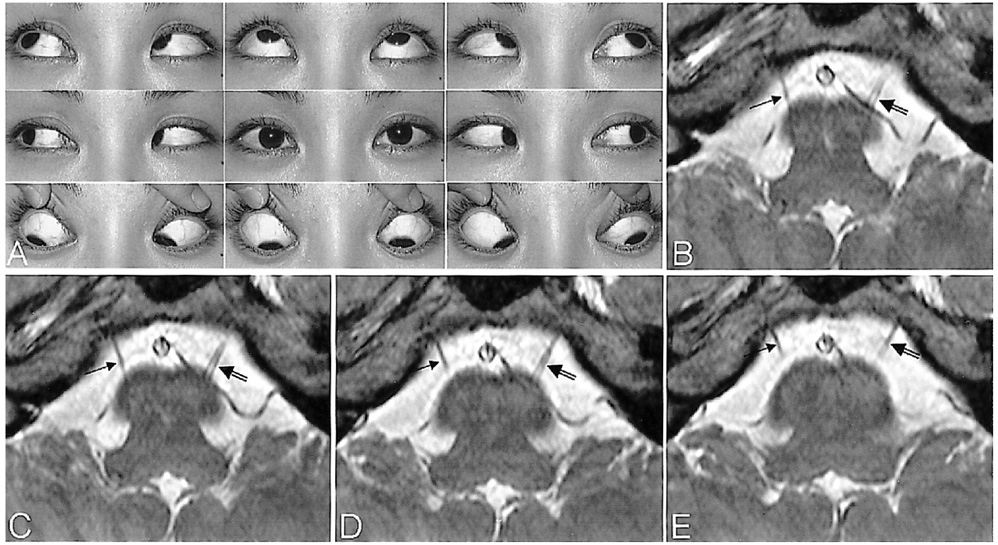Korean J Ophthalmol.
2005 Dec;19(4):305-306. 10.3341/kjo.2005.19.4.305.
Normal Abduction in a Patient with Duplicated Abducens Nerve
- Affiliations
-
- 1Department of Radiology, Seoul National University College of Medicine, Seoul National University Bundang Hospital, Seongnam, Korea. hjm@snu.ac.kr
- 2Department of Ophthalmology, Seoul National University College of Medicine, Seoul National University Bundang Hospital, Seongnam, Korea.
- KMID: 754445
- DOI: http://doi.org/10.3341/kjo.2005.19.4.305
Abstract
- PURPOSE
To our knowledge, there has been no report of ophthalmologic findings related with a duplicated abducens nerve in the ophthalmic literature. This study reports such findings. METHODS: An ophthalmologic examination was performed in one patient with a duplicated abducens nerve, revealed with thin-sectioned magnetic resonance imaging (MRI) across the brainstem level. RESULTS: The MRI disclosed a duplicated left abducens nerve. The patient was orthotropic in five cardinal positions, and her ductions and versions were full. CONCLUSIONS: One patient with a duplicated abducens nerve showed orthotropia and normal ocular movement.
MeSH Terms
Figure
Reference
-
1. Iaconetta G, Tessitore E, Samii M. Duplicated abducent nerve and its course: microanatomical study and surgery-related considerations. J Neurosurg. 2001. 95:853–858.2. Kim JH, Hwang JM. Presence of the abducens nerve according to the type of Duane's retraction syndrome. Ophthalmology. 2005. 112:109–113.3. Kim JH, Hwang JM. Magnetic resonance imaging in patients with abduction deficit found after head trauma. J Neurol. 2005. 252:224–226.4. Kim JH, Hwang JM. Usefulness of MR imaging in children without characteristic clinical findings of Duane's retraction syndrome. AJNR Am J Neuroradiol. 2005. 26:702–705.5. Kim JH, Hwang JM. Hypoplastic oculomotor nerve and absent abducens nerve in congenital fibrosis syndrome and synergistic divergence with magnetic resonance imaging. Ophthalmology. 2005. 112:728–732.6. Ozveren MF, Sam B, Akdemir I, et al. Duplication of the abducens nerve at the petroclival region: an anatomic study. Neurosurgery. 2003. 52:645–652.7. Alkan A, Sigirci A, Ozveren MF, et al. The cisternal segment of the abducens nerve in man: three-dimensional MR imaging. Eur J Radiol. 2004. 51:218–222.
- Full Text Links
- Actions
-
Cited
- CITED
-
- Close
- Share
- Similar articles
-
- Comparison of Palpebral Fissure Height According to Horizontal
- A Case of Abducens Nerve Palsy after Percutaneous Nerve Block for Trigeminal Neuralgia
- A Case of Aberrant Abducens Nerve in a Cadaver and Review of Its Clinical Significance
- A Case of Idiopathic Unilateral Abducens Nerve Palsy in an Adolescent Patient
- Isolated Bilateral Abducens Nerve Palsy Caused by Basilar Artery Dissecting Aneurysm


